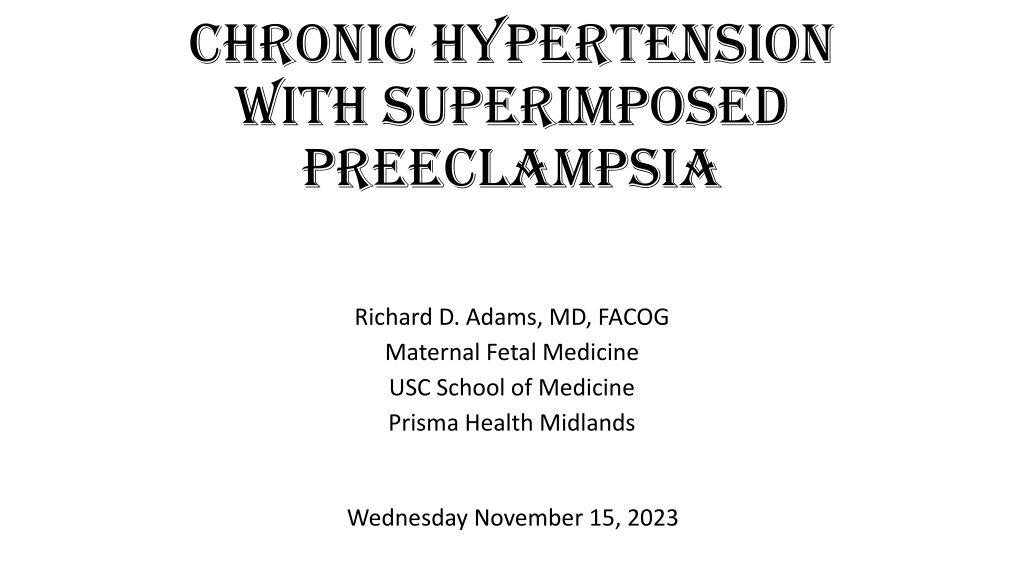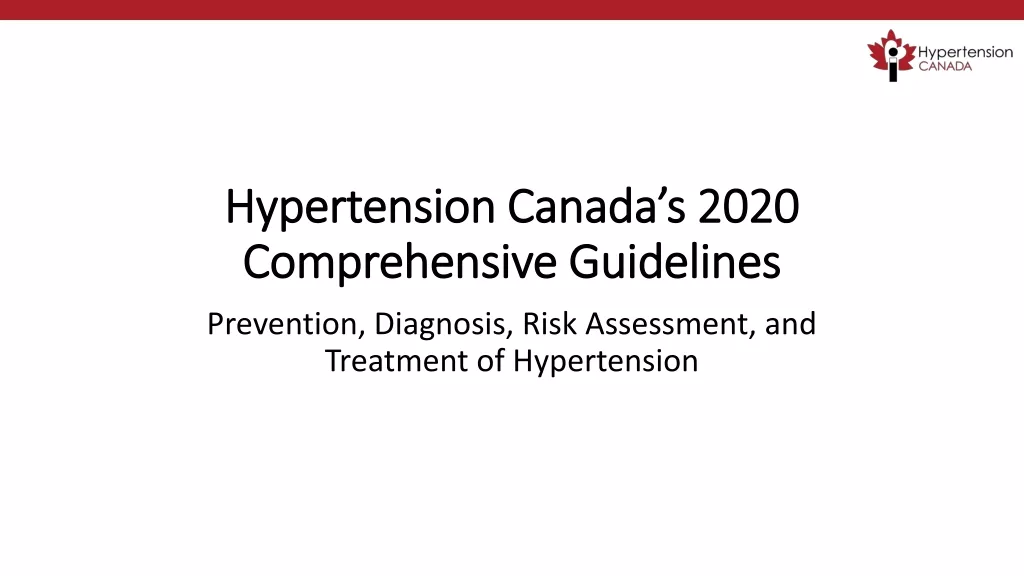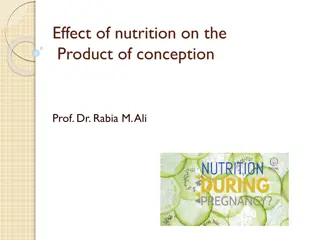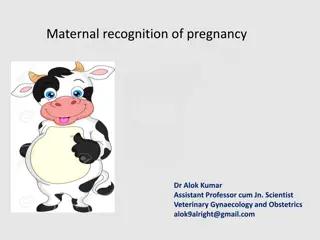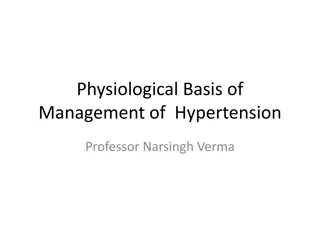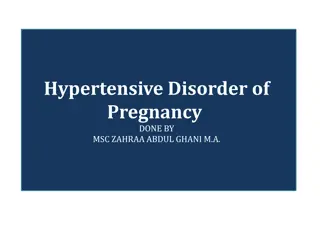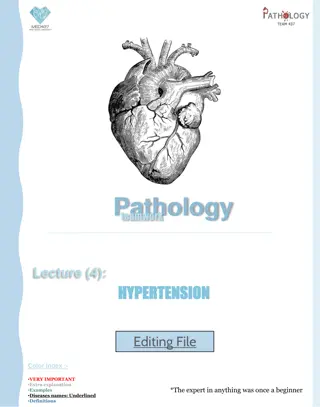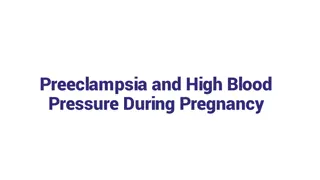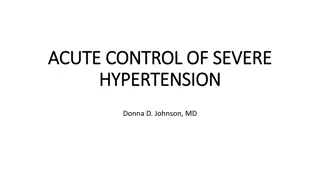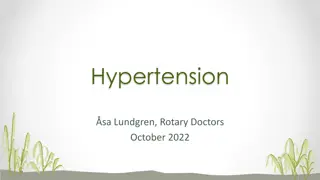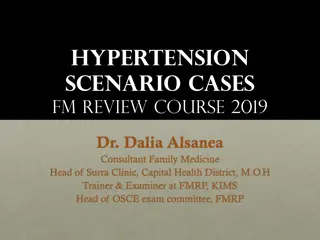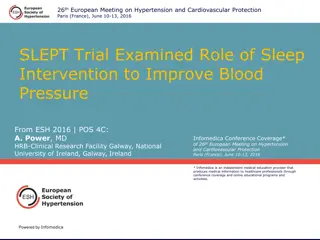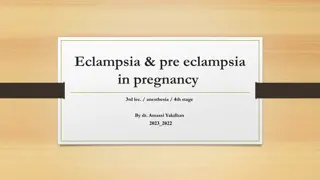Understanding Chronic Hypertension in Pregnancy
Chronic hypertension in pregnancy, sometimes complicated by preeclampsia, poses risks to both mother and baby. The prevalence is increasing, linked to factors like obesity and delayed childbearing. Diagnosis can be challenging due to normal pregnancy physiology masking underlying hypertension. Guidelines for classification and management have evolved, emphasizing early detection and appropriate antihypertensive therapy for high-risk individuals.
Download Presentation

Please find below an Image/Link to download the presentation.
The content on the website is provided AS IS for your information and personal use only. It may not be sold, licensed, or shared on other websites without obtaining consent from the author. Download presentation by click this link. If you encounter any issues during the download, it is possible that the publisher has removed the file from their server.
E N D
Presentation Transcript
Chronic Hypertension with Superimposed Preeclampsia Richard D. Adams, MD, FACOG Maternal Fetal Medicine USC School of Medicine Prisma Health Midlands Wednesday November 15, 2023
Chronic Hypertension The prevalence of chronic hypertension in pregnancy in the United States is estimated to be as high as 3%, and has been increasing over time. Increase attributed to increased prevalence of obesity, metabolic syndrome, and delayed childbearing (AMA) Chronic Hypertension in Pregnancy: Hypertension diagnosed either prior to pregnancy or prior to 20 weeks of gestation Traditionally diagnosed as SBP 140 and/or DBP 90 2 readings at least 4 hours apart unless faced with Severe Hypertension
Chronic Hypertension In 2017, the American College of Cardiology and American Heart Association (ACC/AHA) changed the criteria for classification of hypertension in adults Classification: Category 1: Normal (systolic blood pressure less than 120 mm Hg and diastolic blood pressure less than 80 mm Hg) Category 2: Elevated (systolic blood pressure of 120 129 mm Hg and diastolic blood pressure less than 80 mm Hg) Category 3: Stage 1 hypertension (systolic blood pressure of 130 139 mm Hg or diastolic blood pressure of 80 89 mm Hg) Category 4: Stage 2 hypertension (systolic blood pressure of 140 mm Hg or more or diastolic blood pressure of 90 mm Hg or more). If there is a disparity in category between SBP & DPB, the HIGHER VALUE will determine the category Recommendations to initiate antihypertensive therapy for Category 3 (Stage 1 hypertension) with 1 or more additional findings: Known cardiac disease, Type I or II Diabetes, chronic kidney disease, Age 65 or greater, etc
Chronic Hypertension Establishing a diagnosis of chronic hypertension in pregnancy may not be straightforward In many otherwise health young women, blood pressures may not be known Normal pregnancy physiology may mask previously undiagnosed chronic hypertension
Pregnancy Physiology SBP & DBP fall early in pregnancy Approx. 30% decrease in Systemic Vascular Resistance occurs early May generate up to 10% reduction in BP as early as 7 8 weeks DBP may decrease by up to 20 mm Hg (greater than SBP reduction) Nadir between 16 22 weeks Thus, Normal pregnancy physiology may mask previously undiagnosed chronic hypertension
Chronic Hypertension in Pregnancy BP levels generally return to normal in the 3rd trimester Patients with chronic hypertension may not see a significant decrease in BP early in pregnancy Approx. 11% of women with CHTN have baseline proteinuria (>300 mg/24 hrs) Therefore, may be misdiagnosed as Preeclampsia Makes a diagnosis of superimposed preeclampsia more difficult True distinction between CHTN vs Preeclampsia spectrum may only be evident in retrospect However, 20 50% of pregnant women with CHTN may develop superimposed Preeclampsia
ACOG Definitions ACOG PB 203; Jan 2019
CHTN in Pregnancy - MANAGEMENT Baseline lab evaluation: Complete blood count, Complete Metabolic Profile (electrolytes, LFTs, BUN/Cr) Assessment for Proteinuria Spot urine P:C ratio or 24-hour urine P:C less than 0.15 safely indicates 24-hour urine less than 300 mg Low Dose Aspirin (81 mg) should be initiated between 12 28 weeks (ideally prior to 16 weeks) for preeclampsia risk reduction Electrocardiogram +/- echocardiogram for women with longstanding CHTN Poorly controlled HTN (more than 4 years) or longstanding HTN more likely to have hypertrophic changes, cardiomegaly, and ischemic heart disease
CHTN in Pregnancy - MANAGEMENT Discontinue ACE-inhibitors and Angiotensin Receptor Blockers Risk of fetal/neonatal renal impairment, oligohydramnios, and renal failure Possible increased risk of miscarriage, stillbirth, and congenital anomalies: Oligohydramnios, anuria, renal failure/dialysis, hypotension, pulmonary hypoplasia, Respiratory Distress, fetal growth restriction, limb defects, hypocalvaria, fetal/perinatal death
CHTN in Pregnancy - MANAGEMENT ACOG PB 203; Jan 2019
CHTN in Pregnancy - MANAGEMENT Use of Diuretics in Pregnancy Thiazide diuretics Not associated with fetal anomalies, but theoretical concern about interfering with pregnancy volume expansion Would not initiate during pregnancy (without indication) but not unreasonable to continue if prescribed outside of pregnancy Loop diuretics Not routinely used in the antepartum setting. May be necessary in patients with significant cardiac dysfunction
CHTN in Pregnancy - MANAGEMENT CHAP Trial Published in NEJM in April 2022 Multicenter RCT Pregnant women with mild chronic hypertension enrolled prior to 23 weeks randomized to early treatment vs no treatment until severe-range BP (SBP 160, DBP 105) Findings: reduced risk of preeclampsia with severe features, preterm birth < 35 weeks, placental abruption, fetal/neonatal death) Birthweight less than 10%ile similar in both groups Reference:
CHTN in Pregnancy - MANAGEMENT CHAP Trial (2022)
CHTN with superimposed Preeclampsia Preeclampsia is considered superimposed when it occurs in a patient with previously diagnosed chronic hypertension Distinguishing superimposed PreE from 3rd trimester physiologic increase in BP (and proteinuria) is challenging Sudden increase in previously well controlled BP Need for rapid escalation of antihypertensive medications New onset proteinuria Sudden increase in proteinuria from previously known baseline Presence of Severe Features Severe persistent hypertension despite increasing therapy Thrombocytopenia (platelet < 100,00/microliter) Elevated transaminases (2x upper limit of normal) Severe persistent RUQ/epigastric pain New-onset or worsening renal function Pulmonary Edema Persistent visual or cerebral disturbances
CHTN with superimposed Preeclampsia Suspected superimposed preeclampsia is best monitored initially in the inpatient setting Assessment includes lab evaluation, proteinuria assessment, serial BP monitoring, fetal monitoring. Initial assessment and disposition planning may take 24 48 hours Outpatient management may be appropriate with no evidence of Severe features Home BP monitoring, Weekly or twice weekly office visits, Weekly or twice weekly labs, fetal testing Inpatient management for Preeclampsia with Severe Features
CHTN with superimposed Preeclampsia SMFM SPECIAL REPORT| VOLUME 227, ISSUE 5, PB2-B24, NOVEMBER 2022
Chronic Hypertension with Superimposed PreEclampsia Discussion
